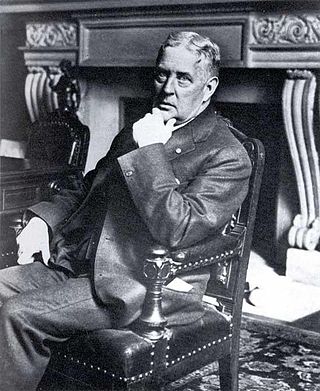
American Impressionism was a style of painting related to European Impressionism and practiced by American artists in the United States from the mid-nineteenth century through the beginning of the twentieth. The style is characterized by loose brushwork and vivid colors with a wide array of subject matters but focusing on landscapes and upper-class domestic life.

The School of the Museum of Fine Arts at Tufts University is the art school of Tufts University, a private research university in Boston, Massachusetts. It offers undergraduate and graduate degrees dedicated to the visual arts.

William McGregor Paxton was an American painter and instructor who embraced the Boston School paradigm and was a co-founder of The Guild of Boston Artists. He taught briefly while a student at Cowles Art School, where he met his wife Elizabeth Okie Paxton, and at the Museum of Fine Arts School in Boston. Paxton is known for his portraits, including those of two presidents—Grover Cleveland and Calvin Coolidge—and interior scenes with women, including his wife. His works are in many museums in the United States.

The Ten American Painters was an artists' group formed in 1898 to exhibit their work as a unified group. John Henry Twachtman, J. Alden Weir, and Childe Hassam were the driving forces behind the organization. Dissatisfied with the conservatism of the American art establishment, the three artists recruited seven others from Boston, New York City, and elsewhere on the East Coast, with the intention of creating an exhibition society that valued their view of originality, imagination, and exhibition quality. The Ten achieved popular and critical success, and lasted two decades before dissolving.

Frank Weston Benson, frequently referred to as Frank W. Benson, was an American artist from Salem, Massachusetts known for his Realistic portraits, American Impressionist paintings, watercolors and etchings. He began his career painting portraits of distinguished families and murals for the Library of Congress. Some of his best known paintings depict his daughters outdoors at Benson's summer home, Wooster Farm, on the island of North Haven, Maine. He also produced numerous oil, wash and watercolor paintings and etchings of wildfowl and landscapes.

Louis Kronberg (1872–1965) was an American figure painter, art dealer, advisor, and teacher. Among his best-known works are Behind the Footlights and The Pink Sash.
The Boston Art Club, Boston, Massachusetts, serves to help its members, as well as non-members, to access the world of fine art. It currently has more than 250 members.

The Boston School was a group of Boston-based painters active in the first three decades of the twentieth century. Often classified as American Impressionists, they had their own regional style, combining the painterliness of Impressionism with a more conservative approach to figure painting and a marked respect for the traditions of Western art history. Their preferred subject matter was genteel: portraits, picturesque landscapes, and young women posing in well-appointed interiors. Major influences included John Singer Sargent, Claude Monet, and Jan Vermeer. Key figures in the Boston School were Edmund C. Tarbell, Frank Weston Benson, and William McGregor Paxton, all of whom trained in Paris at the Académie Julian and later taught at the School of the Museum of Fine Arts. Their influence can still be seen in the work of some contemporary Boston-area artists.

Edmund Charles Tarbell was an American Impressionist painter. A member of the Ten American Painters, his work hangs in the Boston Museum of Fine Arts, Metropolitan Museum of Art, National Gallery of Art, Smithsonian American Art Museum, Corcoran Gallery of Art, DeYoung Museum, National Academy Museum and School, New Britain Museum of American Art, Worcester Art Museum, and numerous other collections. He was a leading member of a group of painters which came to be known as the Boston School.

Elizabeth Okie Paxton (1878–1972) was an American painter, married to another artist William McGregor Paxton (1869–1941). The Paxtons were part of the Boston School, a prominent group of artists known for works of beautiful interiors, landscapes, and portraits of their wealthy patrons. Her paintings were widely exhibited and sold well.

Marion Boyd Allen was an American painter, known for her portraits and landscapes.

Gertrude Horsford Fiske (1879–1961) was an American visual artist, figure painter, still life painter and landscape painter. Fiske was part of the Boston School of painters in the early 20th century. She was the first woman appointed to the Massachusetts State Art Commission in 1929.

Marie Danforth Page (1869–1940) was an American painter, mainly of portraits.

Mary Bradish Titcomb was an American painter, mainly of portraits and landscapes. She is often grouped with the American Impressionists.
Bertha Coolidge (1880–1953) was an American painter of portrait miniatures.
The New England Watercolor Society, originally named the Boston Watercolor Society, is an artist-run organization formed to promote and exhibit work by watercolor painters. It was also at one time known as the Boston Society of Watercolor Painters. It is headquartered in Plymouth, Massachusetts.
Alice Ruggles Sohier (1880–1969) American artist, known for paintings of figures, portraits, still life, and landscapes. She was an active artist between 1900 until around c.1959.


















